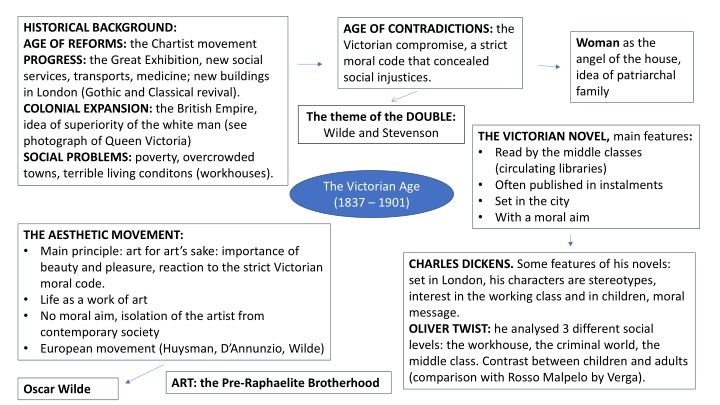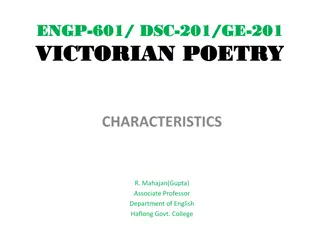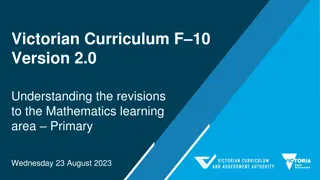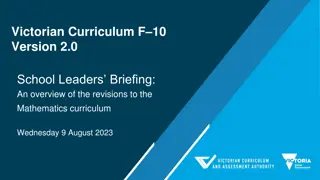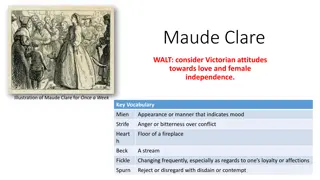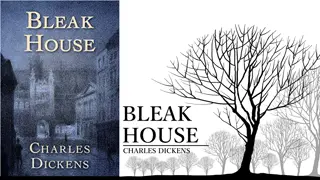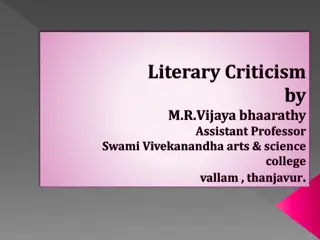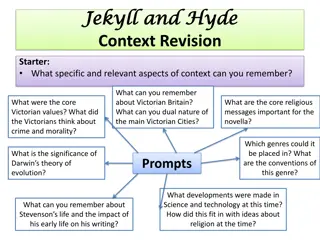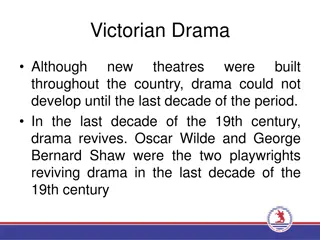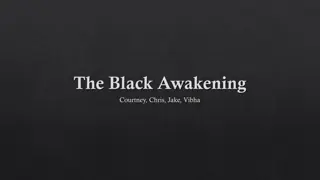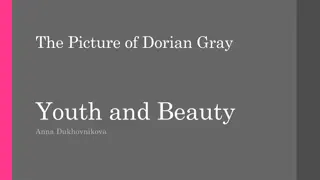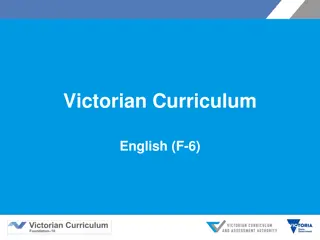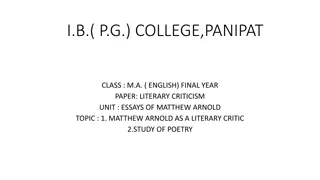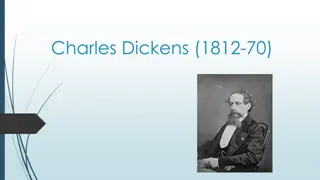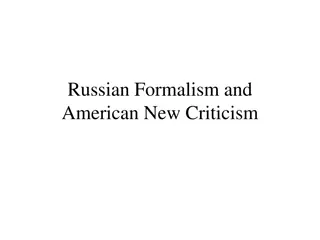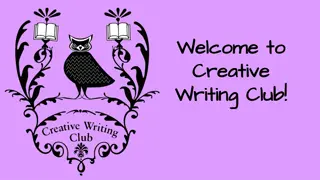Victorian Literary Movement: Aestheticism and Social Critique
The Victorian era was marked by social reforms, colonial expansion, and contradictions like the strict moral code alongside social injustices. Literary figures like Charles Dickens, Oscar Wilde, and Robert Louis Stevenson illuminated these themes through novels exploring duality, hypocrisy, and societal critique, reflecting the complexities of the times. Aestheticism emerged as a reaction to Victorian morality, emphasizing art for art's sake and isolation of the artist from society. Wilde's "The Picture of Dorian Gray" and Stevenson's "The Strange Case of Dr. Jekyll and Mr. Hyde" delve into the depths of human nature, moral dilemmas, and the pursuit of beauty and pleasure.
Download Presentation

Please find below an Image/Link to download the presentation.
The content on the website is provided AS IS for your information and personal use only. It may not be sold, licensed, or shared on other websites without obtaining consent from the author.If you encounter any issues during the download, it is possible that the publisher has removed the file from their server.
You are allowed to download the files provided on this website for personal or commercial use, subject to the condition that they are used lawfully. All files are the property of their respective owners.
The content on the website is provided AS IS for your information and personal use only. It may not be sold, licensed, or shared on other websites without obtaining consent from the author.
E N D
Presentation Transcript
HISTORICAL BACKGROUND: AGE OF REFORMS: the Chartist movement PROGRESS: the Great Exhibition, new social services, transports, medicine; new buildings in London (Gothic and Classical revival). COLONIAL EXPANSION: the British Empire, idea of superiority of the white man (see photograph of Queen Victoria) SOCIAL PROBLEMS: poverty, overcrowded towns, terrible living conditons (workhouses). AGE OF CONTRADICTIONS: the Victorian compromise, a strict moral code that concealed social injustices. Woman as the angel of the house, idea of patriarchal family The theme of the DOUBLE: Wilde and Stevenson THE VICTORIAN NOVEL, main features: Read by the middle classes (circulating libraries) Often published in instalments Set in the city With a moral aim The Victorian Age (1837 1901) THE AESTHETIC MOVEMENT: Main principle: art for art s sake: importance of beauty and pleasure, reaction to the strict Victorian moral code. Life as a work of art No moral aim, isolation of the artist from contemporary society European movement (Huysman, D Annunzio, Wilde) CHARLES DICKENS. Some features of his novels: set in London, his characters are stereotypes, interest in the working class and in children, moral message. OLIVER TWIST: he analysed 3 different social levels: the workhouse, the criminal world, the middle class. Contrast between children and adults (comparison with Rosso Malpelo by Verga). ART: the Pre-Raphaelite Brotherhood Oscar Wilde
OSCAR WILDE ( Dublin 1854 1900) During his lifetime he was especially famous for his theatre production (witty comedies that satirized the Victorian upper classes and its hypocrisy). He also wrote short stories and one novel: THE PICTURE OF DORIAN GRAY: Theme of the double Cult of beauty and pleasure; life as a work of art Hypocrisy of the Victorian middle-class Moral aim (in spite of the Aesthetic principle that art shouldn t have any moral aim). Similarities Wilde D Annunzio: art for art s sake, use of words appealing to the senses, the artist isolates himself in an ideal world of beauty.
Robert Louis Stevenson ( Edinburgh 1850 94) The Strange Case of Dr Jeckyll and Mr Hyde (1886): Theme of the double (reflecting the duality and hypocrisy of Victorian society) social criticism Different motifs related to the theme of the double: moral and physical change of Jekyll, the house with two entrances, double aspect of London streets It doesn t belong to a definite literary genre but has elements in common with: - the Gothic novel (labyrinthine setting, mystery, horror) - the Detective story (Mr Utterson follows the rational logic of the detective; title) Other meanings: Jekyll as an overreacher (he desires forbidden knowledge); the conflict of human nature (good/ evil, spiritual/physical); the human mind as multi-layered (anticipating Freud s studies); satire on contemporary morality Narrative structure: 3 different narrators with different points of view; mixture of realism and symbolism. - Decadentism (solitary protagonist with perverse interests; no moral judgment of the author)
THE PRERAPHAELITE BROTHERHOOD Founded by English painters who had as a model the Italian art of the 13th and 14th centuries (before Raphael) They admired its purity and simplicity in contrast to the ugliness of contemporary industrial society. D.G. ROSSETTI: La Ghirlandata: It combines the vision of the angelic woman with sensuality. WILLIAM MORRIS and the Arts and Crafts Movement: Revival of handicraft for interior design; idea of pleasure both for the creator of the work and for the viewer (in contrast to the alienation of the assembly line and the ugly products of mass production) Patterns inspired by nature
